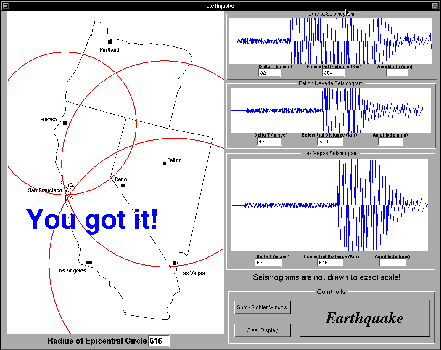
Integrating the Electronic Desktop into the Natural Sciences
Curriculum Development Project at California State University, Los Angeles
Earthquake simulates a large earthquake occurring somewhere in California and displays the seismograms of the s and p seismic waves as they are recorded at three remote stations. From the s-p time interval measured on these seismograms, students can determine the epicentral distance to the simulated earthquake and then using the technique of triangulation locate the epicenter of the quake. By measuring the amplitude of the recorded waves, the Richter magnitude can also be estimated. This application is used in general education introductory geology and oceanography courses. A screen image of the Earthquake window appears below. Earthquake was written by Dr. Gary Novak.

Click to download full resolution image (34.7 KB.)
The Electronic Desktop Project is about improving the way science is taught and learned by bringing the power of advanced workstation technology to introductory science students in both major and general education classes. This involves changing the way in which instruction is delivered using multi-media electronic mail, custom written visualization applications, powerful commercial software packages, and easy-to-use graphical applications that bring the resources of the Internet into the electronic classroom. This project has been funded by grants USE 9153162, DUE 9156142 and DUE 9455428 from the National Science Foundation. For more information contact Dr. Robert Desharnais (biology), (213) 343-2056, rdeshar@calstatela.edu, or Dr. Gary Novak (geology), (213) 343-2406, gnovak@calstatela.edu, California State University, Los Angeles, California, 90032.
 Return to the Application Catalog
Return to the Application Catalog


 Earthquake
Earthquake
 Return to the Application Catalog
Return to the Application Catalog